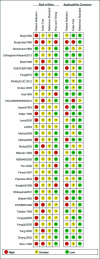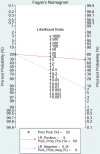Systematic review and meta-analysis of the efficacy of serum neuron-specific enolase for early small cell lung cancer screening
- PMID: 28969076
- PMCID: PMC5610008
- DOI: 10.18632/oncotarget.17825
Systematic review and meta-analysis of the efficacy of serum neuron-specific enolase for early small cell lung cancer screening
Abstract
We performed a pooled analysis of the efficacy of serum neuron-specific enolase (NSE) levels for early detection of small cell lung cancer (SCLC) in patients with benign lung diseases and healthy individuals. Comprehensive searches of several databases through September 2016 were conducted. The quality of the included studies was assessed using the Quality Assessment of Diagnostic Accuracy Studies (QUADAS-2) tool. Ultimately, 33 studies containing 9546 samples were included in the review. Pooled sensitivity of NSE for detecting SCLC was 0.688 (95%CI: 0.627-0.743), specificity was 0.921 (95%CI: 0.890-0.944), positive likelihood ratio was 8.744 (95%CI: 6.308-12.121), negative likelihood ratio was 0.339 (95%CI: 0.283- 0.405), diagnostic odds ratio was 25.827 (95%CI: 17.490- 38.136) and area under the curve was 0.88 (95%CI: 0.85- 0.91). Meta-regression indicated that study region was a source of heterogeneity in the sensitivity and joint models, while cut-off level was a source in the joint model. Subgroup analysis showed that enzyme linked immunosorbent assays had the highest sensitivity and radioimmunoassay assays had the highest specificity. The diagnostic performance was better in Europe [sensitivity: 0.740 (95%CI: 0.676-0.795), specificity: 0.932 (95%CI: 0.904-0.953)] than in Asia [sensitivity: 0.590 (95%CI: 0.496- 0.678), specificity: 0.901 (95%CI: 0.819-0.948)]. In Europe, 25 ng/ml is likely the most suitable NSE cut-off level. NSE thus has high diagnostic efficacy when screening for SCLC, though the efficacy differs depending on study region, assay method and cut-off level. In the clinic, NSE measurements should be considered along with clinical symptoms, image results and histopathology.
Keywords: diagnosis accuracy; meta-analysis; neuron-specific enolase; small cell lung cancer; systematic review.
Conflict of interest statement
CONFLICTS OF INTEREST There is no conflicts of interest for any author regarding the publication of this manuscript.
Figures










Similar articles
-
Methodological and clinical evaluation of two automated enzymatic immunoassays as compared with a radioimmunoassay for neuron-specific enolase.Eur J Clin Chem Clin Biochem. 1996 Aug;34(8):679-82. Eur J Clin Chem Clin Biochem. 1996. PMID: 8877347
-
[Role of the cut-off value of serum neuron-specific enolase in differentiating small cell lung cancer from non-small cell lung cancer].Nan Fang Yi Ke Da Xue Xue Bao. 2006 Jun;26(6):858-9. Nan Fang Yi Ke Da Xue Xue Bao. 2006. PMID: 16793621 Chinese.
-
[The clinical value of vascular endothelial growth factor in patients with small cell lung cancer].Zhongguo Fei Ai Za Zhi. 2007 Oct 20;10(5):406-10. doi: 10.3779/j.issn.1009-3419.2007.05.12. Zhongguo Fei Ai Za Zhi. 2007. PMID: 21126410 Chinese.
-
Does the assessment of serum markers in patients with lung cancer aid in the clinical decision making process?Anticancer Res. 1996 Jul-Aug;16(4B):2161-8. Anticancer Res. 1996. PMID: 8694537 Review.
-
Neuron-Specific Enolase as a Biomarker: Biochemical and Clinical Aspects.Adv Exp Med Biol. 2015;867:125-43. doi: 10.1007/978-94-017-7215-0_9. Adv Exp Med Biol. 2015. PMID: 26530364 Review.
Cited by
-
The establishment of neuron-specific enolase reference interval for the healthy population in southwest China.Sci Rep. 2020 Apr 14;10(1):6332. doi: 10.1038/s41598-020-63331-x. Sci Rep. 2020. PMID: 32286436 Free PMC article.
-
Evaluating the diagnostic and prognostic value of serum TuM2-PK, NSE, and ProGRP in small cell lung cancer.J Clin Lab Anal. 2023 Apr;37(7):e24865. doi: 10.1002/jcla.24865. Epub 2023 Apr 23. J Clin Lab Anal. 2023. PMID: 37088873 Free PMC article.
-
Recent Advances and Implication of Bioengineered Nanomaterials in Cancer Theranostics.Medicina (Kaunas). 2021 Jan 21;57(2):91. doi: 10.3390/medicina57020091. Medicina (Kaunas). 2021. PMID: 33494239 Free PMC article. Review.
-
SCLC: Epidemiology, Risk Factors, Genetic Susceptibility, Molecular Pathology, Screening, and Early Detection.J Thorac Oncol. 2023 Jan;18(1):31-46. doi: 10.1016/j.jtho.2022.10.002. Epub 2022 Oct 12. J Thorac Oncol. 2023. PMID: 36243387 Free PMC article. Review.
-
Multifunctional neuron-specific enolase: its role in lung diseases.Biosci Rep. 2019 Nov 29;39(11):BSR20192732. doi: 10.1042/BSR20192732. Biosci Rep. 2019. PMID: 31642468 Free PMC article. Review.
References
-
- Micke P, Faldum A, Metz T, Beeh KM, Bittinger F, Hengstler JG, Buhl R. Staging small cell lung cancer: Veterans Administration Lung Study Group versus International Association for the Study of Lung Cancer—what limits limited disease? Lung Cancer. 2002;37:271. doi: 10.1016/S0169-5002(02)00072-7. - DOI - PubMed
-
- Anna N, Bunn PA, Jr., Langer C, Einhorn L, Guthrie T, Jr., Beck T, Ansari R, Ellis P, Byrne M, Morrison M, Hariharan S, Wang B, Sandler A. Randomized phase III trial comparing irinotecan/cisplatin with etoposide/cisplatin in patients with previously untreated extensive-stage disease small-cell lung cancer. J Clin Oncol. 2006;24:2038–43. doi: 10.1200/jco.2005.04.8595. - DOI - PubMed
LinkOut - more resources
Full Text Sources
Other Literature Sources

